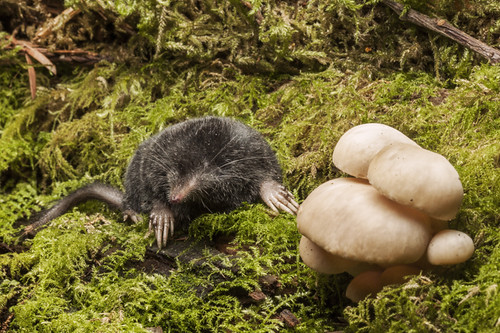
American Shrew Mole and Oyster Mushrooms
American Shrew Mole
Neurotrichus gibbsii
A distinct trait of the American shrew mole is their living behavior. Unlike other mole species, mounds don't necessarily form in an instant from their burrow system. The reason for this is that they usually work on small pathways, choosing softer soil and leaf litter. Their also known to scale shrub places and small bushes, even traversing very close to the surface. Some studies suggest they can also swim and dive in river streams and lake.
This mole's mating season can happen all year round as their drive would display towards other moles. They can have one to four young within a year. This mole species breeding habits has supported their population to be in good numbers throughout the country just like other small mammals of their size.
This wildlife animal can be found in territories in Pacific Northwest, including the central region of California. The states of Oregon and Washington also have frequent sightings of the American Shrew Mole. They can be active in night time, as well as daytime.
Their favorite food source are insects found on the earth. This can be earthworms, larvae, mites, sowbugs, invertebrates and even young small mice. Contrary to other wildlife creatures, they do not go in hibernation, with studies showing this species of mole to be gregarious.
This mole's natural habitat includes river banks, alder thickets, streams, willows and nearby lake shores. They would most likely stay in deep litter leaves and in some heavy covers of shrubs. Studies show they prefer soft soils in low level locations, including mud bare places. They seem to have the ability to live up to 8,000 feet. The wild animal particularly dissent hard earth soil and sod grass.
This shrew mole species has an average of 3.1 to 3.5 inches length including body and head. Their tail can range from 2.0 to 2.3 inches. Compared to other mole varieties, their shorter and smaller. The fur on their body has black, grey to dark color shades, with peppered gray fur on their coats.
The mole's usual choice of territory, according to zoologists, is in places which is not easy to cultivate, making them neutral in terms of economic and ecological effects. However, despite the mole's small size and unique behaviors, it is said to have caused damages to lawns of properties where it finds its way.
The American Shrew Mole sometimes display a short powerful burst of energy, with short rest periods that follow. Observations suggest their not as physically equipped in deep and long digging compared to other mole species. This trait has since force them to spend significant time above the surface on the ground.
Their burrow tunnel system can be shared with other of their species. Their one of the few moles which can form significantly large group up to 14 member moles. The mole do not usually build their nest below the ground and would have their nest above ground, usually made of dry leaves.
The American Shrew Mole can handled by mole trapping and mole trapper. You can contact a wildlife removal company for inquiries and other issues concerning moles, digging animals and other nuisance animals. They have wildlife professionals which can handle these animals in humane manner, within state and national laws.
